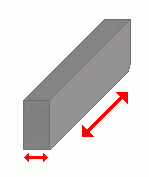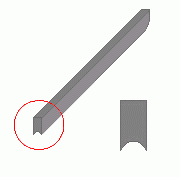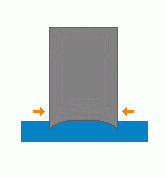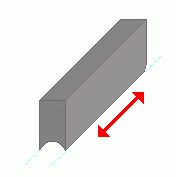  Hockey skate blades must be sharpened in a particular way, to insure that there is sideways friction but very little forwards friction. Here's how it works.
Hockey skate blades must be sharpened in a particular way, to insure that there is sideways friction but very little forwards friction. Here's how it works.The blade on a hockey player's skate is not flat, even after it has been sharpened. If it were flat, as shown in the diagram at the right, the skate would be able to slide sideways just as easily as it slides forwards. Players would have difficulty maintaining their balance, and would find it very difficult to push themselves forward, or turn.   The blade is actually sharpened with a groove down its length. This shallow depression allows the thin edges of the blade on either side to bite into the ice. The result is a
The blade is actually sharpened with a groove down its length. This shallow depression allows the thin edges of the blade on either side to bite into the ice. The result is a This prevents the skate from sliding sideways easily, giving the player more stability. It also allows the player to apply a force to the ice sideways, allowing him to turn his skate and push ... to move forward or to stop.  The groove with its two sharp edges has very little friction in the forwards and backwards direction; this allows the skater to glide in these directions easily, despite the pressure forcing the grooves into the ice.
The groove with its two sharp edges has very little friction in the forwards and backwards direction; this allows the skater to glide in these directions easily, despite the pressure forcing the grooves into the ice.Hockey goalies, however, need to be able to slide more freely from side to side; as a result, the groove in their skate blades is much shallower, resulting in lesser lateral friction. |